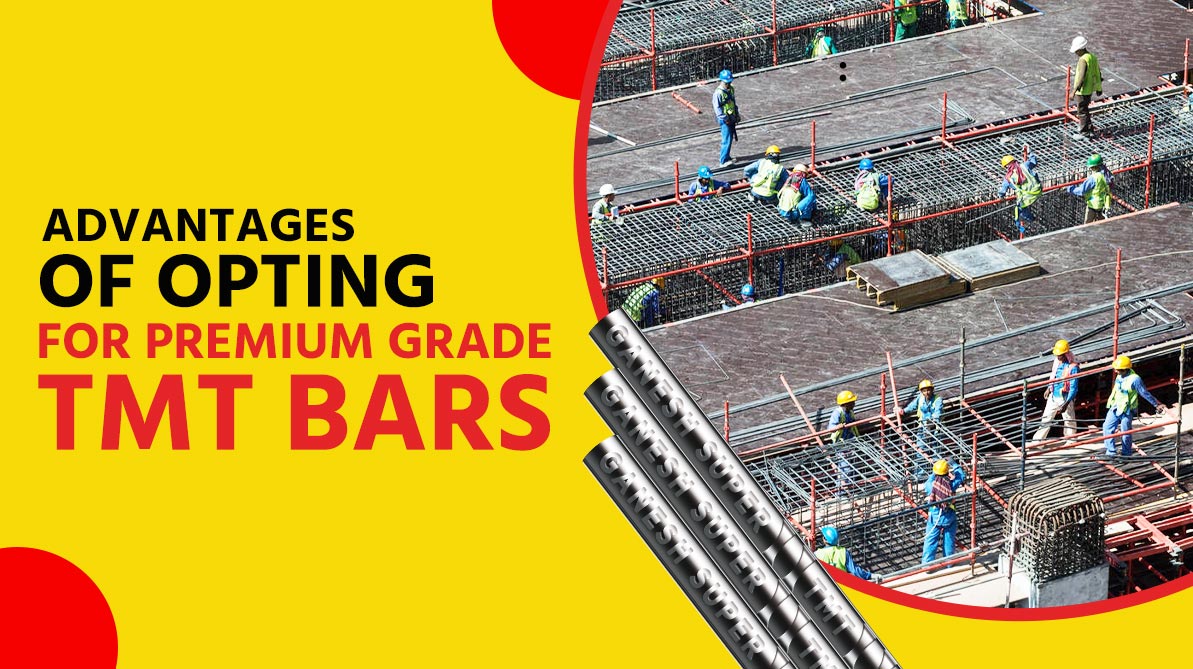The demand for stronger, more durable, and sustainable building materials is at an all-time high now than ever. Technological advancements are not only reshaping processes but revolutionizing entire industries. One such domain experiencing transformation in the manufacturing processes is the TMT bars. Thermo mechanically treated (TMT) bars have been a trusted solution for adding superior strength and seismic resistance to constructed structures compared to traditional steel bars. These bars are experiencing a shift due to the integration of advanced technologies. In this blog, you will learn the innovations that are driving a transformation into the TMT bar manufacturing industry and the significant implications they hold in the construction industry.
What Are TMT Bars?
Before diving into the advancements, we need to understand what TMT bars are and their significance in the construction industry. TMT bars are a type of steel reinforcement bar commonly used in reinforced concrete structures. They undergo a specialized manufacturing process that involves controlled heating and cooling. This is known as the thermomechanical treatment. This treatment gives superior strength and ductility when compared to traditional steel bars.
The process of manufacturing TMT bars has been constantly evolving since its introduction in 1979. Let us discuss some of the future developments below:
Industry 4.0 Integration
The fourth industrial revolution, often referred to as Industry 4.0, has spread through every aspect of the manufacturing industry. The TMT production is no exception. Smart factories equipped with Internet of Things (IoT) sensors, robotics, and data analytics are optimising production processes. This enhances efficiency and ensures consistent quality control.
Automated Production Line
Traditional TMT manufacturing involves significant manual intervention. This leads to variation in quality and output. This is where automated production limes come in. These production devices are powered by robotics and artificial intelligence (AI) and are streamlining operations, minimising human errors, and increasing productivity. These advancements result in precise control over the special thermomechanical treatment process. This ensures the desired mechanical properties in the final product.
Advanced Alloy Development
Material science involves the study, design, and development of new materials. It uses the fundamental principles of chemistry, physics, and engineering to solve problems that benefit society. Advancements in material science have led to the development of high-strength alloys tailored specifically for TMT bars. These alloys show high strength, corrosion resistance, and weldability. This makes them ideal for demanding construction projects that take place in areas with high seismic activities, underwater, or have to bear heavy loads. Moreover, the use of recycled materials and sustainable alloys aligns with the industry’s growing focus on environmental sustainability.
Predictive Maintenance
Downtime in manufacturing facilities can be costly and disruptive. To get rid of this problem, predictive maintenance techniques utilizing AI and machine learning algorithms are being employed. These techniques can foresee equipment failures before they occur. Manufacturers can now schedule maintenance proactively by monitoring equipment performance in real-time and detecting anomalies. This minimises unplanned downtime and helps in optimising production schedules.
Quality Assurance Through Data Analytics
Data analytics tools are revolutionizing quality assurance practices in TMT manufacturing. TMT bar manufacturers can now identify patterns, detect defects, and fine-tune manufacturing parameters to ensure consistent product quality, all by analyzing vast amounts of production data in real time. This proactive approach enhances customer satisfaction and reduces waste and rework. It leads to cost savings in the long run.
Beyond The Blast Furnace
Traditionally, TMT bar production relied heavily on blast furnaces. This process consumed a substantial amount of energy and had a huge environmental impact. In the present day, innovative technologies are paving the way for cleaner and more efficient methods. One of these technologies is the Electric Arc Furnace (EAF). This technology utilises recycled scrap steel and significantly reduces raw material extraction and carbon emissions. Induction heating offers precise temperature control during the thermomechanical treatment, which leads to improved strength and consistency in the final product. Continuous casting is replacing traditional ingot casting, which results in uniformity, reduced waste, and increased production efficiency.
The Precision Revolution
Automation and data analytics are playing a crucial role in improving the production process of TMT bars. Robotic automation handles repetitive tasks like material handling and quality control. That ensures accuracy and safety. The best TMT bar companies can now improve their processes even further by monitoring real-time data. This allows adjustments in production parameters on-the-go, optimizes quality, and also prevents defects. Machine learning algorithms analyze vast amounts of data to predict potential issues and suggest preventive measures that ensure consistent quality and minimise waste.
Sustainable Strength
The word ‘sustainability’ is trending nowadays; however, it is more than just a buzzword. It is a driving force in TMT manufacturing advancements. Closed-loop water recycling systems help minimise water usage and wastewater generation. Companies are also increasingly adopting renewable energy sources like solar power to reduce the carbon footprint of production. By-product utilisation is transforming waste materials into valuable resources and promoting a circular economy approach.
How Will The Construction Sector Benefit From Advanced Technologies?
Enhanced Structural Integrity
TMT bars manufactured using advanced technologies offer superior strength, ductility, and corrosion resistance. This enhances the structural integrity and longevity of reinforced concrete structures. This means safer and more durable buildings, bridges, and infrastructure projects.
Cost Efficiency
The initial investment in advanced manufacturing technologies may be high, but the long-term benefits significantly outweigh it. Improved productivity, reduced material wastage, and enhanced quality control lead to cost savings throughout the construction lifecycle. This makes construction projects more financially viable in the long run.
Sustainability
The use of advanced alloys and sustainable manufacturing practices contributes to environmental sustainability. This is done by reducing carbon emissions and conserving natural resources. Additionally, the durability of TMT bars ensures fewer replacements over time, further reducing the environmental impact of construction activities.
Competitive Advantage
The best TMT bar companies are now embracing advanced TMT manufacturing technologies to gain a competitive advantage in the market. They can now attract more clients by offering high-quality, reliable, and technologically advanced products. This will strengthen their market position in an increasingly competitive landscape.
Who Will Benefit From These Advancements?
Manufacturers
● Increased efficiency through automation, data analytics, etc., leads to faster production cycles, reduced downtime, and lower operational costs.
● Improved product quality through precise control over production means consistent quality, which will increase brand reputation.
● Sustainable practices will result in a reduced environmental footprint and attract environmentally conscious clients.
Construction Companies
● Advanced TMT bars offer higher strength, weldability, and earthquake resistance, enabling the construction of safer and more resilient buildings.
● Better quality TMT bars mean lower maintenance needs and longer infrastructure lifespans, which saves costs of repairs and replacements.
● Efficient production and increased availability of high-quality TMT bars can lead to faster construction timelines.
The Bottom Line
The advancements in TMT manufacturing represent a fundamental shift in the construction industry that is driven by the convergence of technology, material science, and sustainability. Some might think that investing in innovation is just about staying ahead of the curve. However, it is so much more than this simple thought. It is about building a stronger and more sustainable future. These advanced technologies are reshaping how TMT bars are produced and utilised in construction projects. As this industry continues to evolve, adopting these technologies will be crucial for staying ahead of the competition and meeting the ever-increasing demands.





